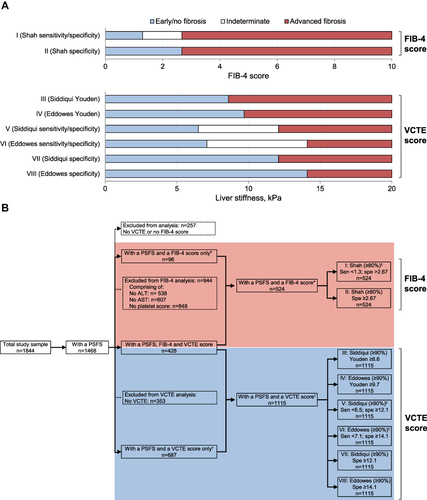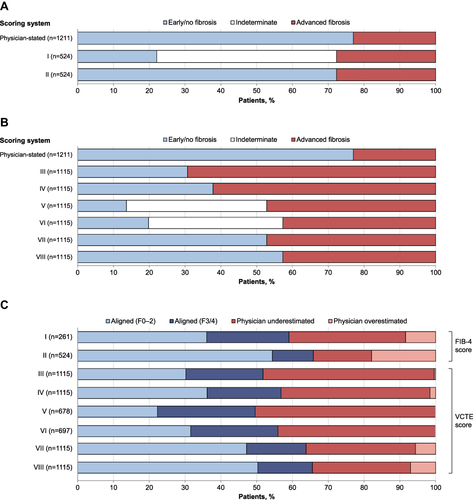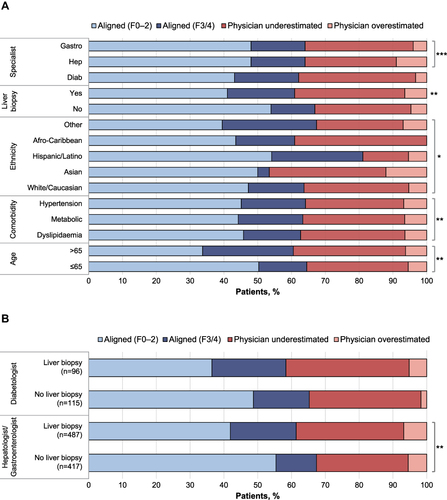Figures & data
Figure 1 (A) Correlation of FIB-4 and VCTE scores with fibrosis stage according to published thresholds. Thresholds were applied at the 80% threshold for FIB-4 and 90% threshold for VCTE and defined by either sensitivity, specificity, or Youden’s Index. Patients with indeterminate non-alcoholic steatohepatitis were also included in subsequent sizing of patient fibrosis groups. (B) Study flow using these thresholds. Patient cohorts were generated using the thresholds described in key references for the presence of advanced fibrosis (specificity; true positive) and absence of advanced fibrosis (sensitivity; true negative). In some cases, upper and lower limits were applied, omitting an “indeterminate” group of patients in whom the presence or absence of advanced fibrosis could not be confirmed. Youden’s Index is the threshold that optimizes the biomarker’s differentiating ability when equal weight is given to sensitivity and specificity. *A FIB-4 score could not be derived if any one of the four components required (ALT, AST, platelet count, or age) was not available. Patients were excluded if their derived FIB-4 score was >10. Only the most recent FIB-4 score was available. †VCTE scores were available at diagnosis and most recent. ‡Indicates scoring systems that include indeterminate patients.

Table 1 Patient Demographics and Clinical Characteristics
Figure 2 Physician-stated fibrosis score according to published scoring systems. (A) Patients with a FIB-4 score and a PSFS; the PSFS is for the 524 patients with a FIB-4 score. (B) Patients with a VCTE score and a PSFS; the PSFS is for the 1115 patients with a VCTE score. (C) Alignment of PSFS and CRFS scoring according to published scoring systems. Scoring systems as previously published:Citation15,Citation18,Citation19 I: Shah (FIB-4 90% Sen<1.3, Spe>2.67); II: Shah (FIB-4 90% Spe>2.67); III: Siddiqui (VCTE Youden 8.6); IV: Eddowes (VCTE Youden 9.7); V: Siddiqui (VCTE 90% Sen<6.5, Spe≥12.1); VI: Eddowes (VCTE 90% Sen<7.1, Spe≥14.1); VII: Siddiqui (VCTE 90% Spe≥12.1); VIII: Eddowes (VCTE 90% Spe≥14.1). All values are kPa. F0−2 indicates no fibrosis/early fibrosis; F3/4 indicates advanced fibrosis or cirrhosis.

Figure 3 Alignment of PSFS and CRFS scoring according to published scoring systems. All values are kPa. (A) Alignment of fibrosis using PSFS versus VCTE scores using the Siddiqui (VCTE specificity ≥12.1) threshold according to age, comorbidity, ethnicity, treating physician specialty and whether liver biopsy had been performed (VCTE cohort; n=1115); (B) alignment rates according to physician specialty and whether patients had undergone liver biopsy (VCTE cohort; n=1115). F0−2 indicates no fibrosis/early fibrosis; F3/4 indicates advanced fibrosis or cirrhosis. Metabolic indicates presence of any of: metabolic syndrome, T2DM, insulin resistance or hyperglycemia. (A) *p < 0.05, **p < 0.01, ***p < 0.0001. (B) **p < 0.001 for liver biopsy vs non-invasive testing.

Figure 4 Alignment between PSFS and CRFS: sensitivity analyses. (A) VCTE-suitable patients (excludes patients: aged ≥65 years; who are morbidly obese [body mass index ≥35 kg/m2]; with T2DM; or with physician-reported hypertension) versus VCTE non-suitable patients); (B) at-diagnosis VCTE data; and (C) liver biopsy versus no liver biopsy. F0−2 indicates no fibrosis/early fibrosis; F3/4 indicates advanced fibrosis or cirrhosis. (A) *p < 0.05, **p<0.01 vs VCTE-unsuitable patients. (B) **p < 0.01 vs current VCTE data. (C) **p < 0.01; ***p < 0.0001 for liver biopsy vs no liver biopsy. Scoring systems as previously published.Citation15,Citation18,Citation19 All values are kPa.
![Figure 4 Alignment between PSFS and CRFS: sensitivity analyses. (A) VCTE-suitable patients (excludes patients: aged ≥65 years; who are morbidly obese [body mass index ≥35 kg/m2]; with T2DM; or with physician-reported hypertension) versus VCTE non-suitable patients); (B) at-diagnosis VCTE data; and (C) liver biopsy versus no liver biopsy. F0−2 indicates no fibrosis/early fibrosis; F3/4 indicates advanced fibrosis or cirrhosis. (A) *p < 0.05, **p<0.01 vs VCTE-unsuitable patients. (B) **p < 0.01 vs current VCTE data. (C) **p < 0.01; ***p < 0.0001 for liver biopsy vs no liver biopsy. Scoring systems as previously published.Citation15,Citation18,Citation19 All values are kPa.](/cms/asset/de9ee5f5-30e8-4d6f-8563-ff7eec4e187f/dpor_a_12155728_f0004_c.jpg)
